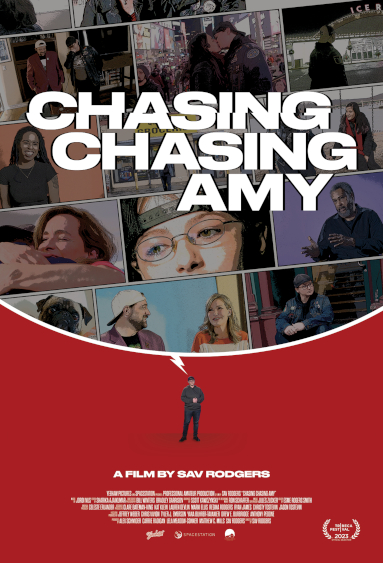Eye For Film >> Movies >> Chasing Chasing Amy (2023) Film Review
Chasing Chasing Amy
Reviewed by: Jennie Kermode

If you have seen Chasing Amy, your reaction to it is likely to be significantly influenced by two things: your sexual orientation, and when you saw it. For straight people, it’s just a film, written to appeal to a certain type of wistful romantic or comics nerd, and with decent central performances – perhaps a little exotic, in its time, because of its inclusion of queer characters. For queer people, it’s more complicated. On its initial release, its bolstering of the popular myth that lesbians are just waiting for the right man to change their lives was seriously aggravating, not least because it contributed to the harassment that lesbian and bisexual women frequently experienced. Now, however, when LGBTQ+ people in general are seen as a more ordinary part of the landscape, both in cinema and in the average straight person’s life, it’s less problematic, even if it still comes across as a bit clueless. To a younger generation, it has meant something quite different.
As director Sav Rodgers explains in his TED Talk, a clip from which introduces this documentary, it’s a film that saved his life. As a kid who was experiencing homophobia before he even knew he was queer, growing up without any access to other supportive material or community, it was a film he watched “at least once a day,” that gave him something to hold onto. He was shocked when, a few years later, he learned that some people in the LGBTQ+ community didn’t like it. It was his desire to understand that which led to this documentary.

Then there was the message that he got from Kevin Smith when the director saw his TED Talk, and the experience not only of talking to his hero but of getting his support at a stage when he was just beginning to come out as a trans man. This human story elevates everything about the documentary because it acts as a reminder that filmmakers are human beings, that people’s different life experiences drastically affect the way they relate to cinema, and that far from creative divisions, these are things which can enrich all of our experiences.
An instant hit on the festival circuit, Chasing Chasing Amy screened as part of 2024’s BFI Flare, where it received an enthusiastic welcome. It explores Smith’s film in depth, with extensive contributions from a director who is quite willing to acknowledge his mistakes, and who brings the passion for cinema for which he is well known. He discusses the influences which shaped the original script, including producer Scott Mosier’s crush on Go Fish director Guinevere Turner, herself a lesbian, and his own relationship with Dazed And Confused star Joey Lauren Adams, which was gradually disintegrating during the development process. Smith and Adams are on amicable terms and she also gets an extensive opportunity to contribute here. It’s a very personal take but everybody seems to be comfortable with it, and it provides a level of emotional insight that’s rare in any documentary.
For his part, Rodgers told me that he never intended the film to reveal as much about his own life as it does, and that was hard for him – something which will be particularly evident to transitioned viewers who know what it can feel like to see ‘before’ pictures (though of course any number of people are uncomfortable when confronted with reminders of their younger selves). His courage in persisting, however, has really paid off. Watching him transition slowly over time is a wonderful antidote to the myth of the magical moment in surgery, as the complete acceptance of those around him challenges the idea that trans people will always be unhappy. We also follow him through a developing romance with, well, a lesbian, and the good news is that Chasing Amy got it right when it recognised that, under the right circumstances, feelings and identities can be fluid.
Alongside this, we see Rodgers’ development as a filmmaker, growing confident partly thanks to Smith but mostly as a result of experience, finding his voice. The result is a multi-layered journey into the filmmaking process, in which mistakes are as valuable as successes as long as one learns from them, and in which curiosity about the experiences of other people emerges as the glue that binds communities together, as well as enabling them to intersect in positive, creatively productive ways.
Reviewed on: 18 Mar 2024
















